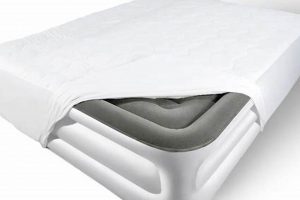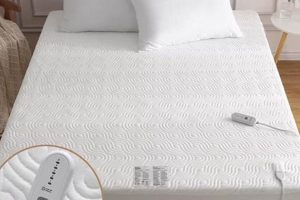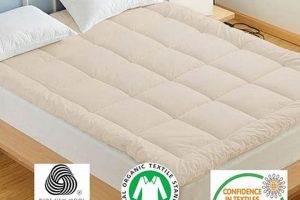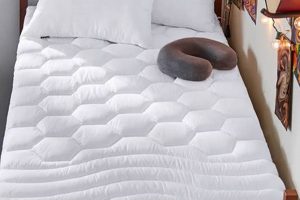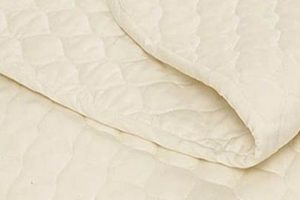A temperature-controlled bedding accessory designed to fit a standard 60-inch by 80-inch bed, this device provides supplemental warmth to the user while sleeping. These pads typically utilize electric resistance heating elements woven into the fabric, allowing for adjustable temperature settings. For instance, one may choose a low setting for mild comfort or a higher setting during colder months for more substantial warmth.
The value of such a product stems from its ability to enhance sleep quality and overall comfort. By providing consistent and adjustable warmth, it can alleviate muscle tension, promote relaxation, and reduce the need for excessive blankets. Historically, methods for warming beds included hot water bottles or warming pans. Modern electric pads offer a more convenient and controlled solution, contributing to improved sleep hygiene and potential energy savings by reducing the need to heat an entire room.
The following sections will explore various aspects of these devices, including their different types, key features to consider when purchasing, safety precautions, and maintenance tips to ensure longevity and optimal performance.
Selecting the Optimal Bed Warmer
Choosing the appropriate device for maintaining a comfortable sleeping temperature requires careful consideration. The following guidelines aim to assist in making an informed decision.
Tip 1: Prioritize Safety Certifications: Ensure the selected model possesses certifications from recognized testing laboratories (e.g., UL, ETL). These certifications indicate adherence to established safety standards regarding electrical components and heat distribution, minimizing potential hazards.
Tip 2: Evaluate Material Composition: Opt for pads constructed from breathable and hypoallergenic materials. Cotton or bamboo blends can enhance airflow and reduce the risk of allergic reactions, contributing to a more restful sleep environment.
Tip 3: Assess Heating Zone Control: Models with independent heating zones offer personalized comfort. This feature allows for varying temperature settings for different sections of the bed, catering to individual preferences and needs.
Tip 4: Consider Washability and Care: Look for machine-washable options to simplify maintenance. Adherence to the manufacturer’s cleaning instructions is crucial for preserving the integrity of the heating elements and fabric.
Tip 5: Examine Controller Functionality: Evaluate the ease of use and features of the controller. Backlit displays, auto-off timers, and multiple temperature settings enhance convenience and safety.
Tip 6: Check Warranty Coverage: A comprehensive warranty demonstrates the manufacturer’s confidence in their product’s durability and reliability. Review the warranty terms and conditions to understand the scope of coverage.
Tip 7: Read Reviews and Ratings: Researching user reviews and ratings provides valuable insights into the real-world performance and durability of different models. Pay attention to feedback regarding heating consistency, controller reliability, and customer support.
Adhering to these suggestions will aid in selecting a safe, comfortable, and durable product that effectively regulates sleeping temperature, promoting enhanced rest and well-being.
The subsequent sections will delve into the proper usage and long-term maintenance practices for heated bedding accessories.
1. Dimensions
The dimensional specifications of a bedding accessory directly influence its functionality and user satisfaction. Accurate sizing is paramount for effective operation and comfort.
- Queen Size Standardization
The term “queen size” denotes a standardized bed dimension, typically 60 inches in width and 80 inches in length. A heating pad designed for a queen-sized bed must conform to these dimensions to ensure complete coverage and proper fit. Deviations can result in areas of the mattress remaining unheated or the pad bunching up, compromising comfort and performance.
- Edge Accommodation
The dimensional design should account for mattress depth. Pockets or elasticized edges secure the pad to the mattress, preventing slippage. Insufficient depth accommodation leads to instability and potentially exposes the heating elements, posing a safety risk.
- Control Placement Considerations
Pad dimensions must integrate seamlessly with controller placement. Cords should be long enough to reach a bedside table without straining or creating a tripping hazard. A poorly considered dimensional design can negatively impact accessibility and safety.
- Shrinkage Allowance
Manufacturing must account for potential shrinkage during washing. Pre-shrinking fabrics or incorporating dimensional tolerances mitigates the risk of the pad becoming too small after cleaning, preserving its fit and functionality.
The interplay between these dimensional factors is critical for ensuring a correctly fitting, safe, and effective product. A device that accurately adheres to the standard queen-size dimensions, accommodates mattress depth, considers controller placement, and accounts for shrinkage will deliver optimal performance and user satisfaction.
2. Temperature Control
Effective temperature regulation is a fundamental element of a heated mattress pad of any size, most notably a queen size. Its ability to precisely and consistently control temperature directly influences user comfort, safety, and energy efficiency. Malfunctions in the temperature control system can lead to overheating, posing a fire hazard or causing discomfort. Accurate temperature management ensures even heat distribution across the pad’s surface. The absence of precise temperature control undermines the core value proposition, potentially rendering the device unusable or hazardous.
Consider a scenario where a pad lacks temperature control: users are restricted to a single, potentially excessive, heat level. Individuals with varying thermal preferences or health conditions cannot customize their sleep environment. A user experiencing a fever, for instance, may find such a device detrimental. Advanced temperature control systems often incorporate multiple heat settings, timers, and automatic shut-off functions, enhancing safety and convenience. Dual-zone control in queen-size pads further accommodates differing thermal needs between partners sharing the bed, representing a practical application of precise regulation.
In summary, temperature control is not merely an ancillary feature but an indispensable component of the heated mattress pad. Its performance is directly correlated with user satisfaction and safety. Challenges in temperature regulation arise from sensor inaccuracies, heating element inconsistenc
ies, and controller malfunctions. Understanding the significance of temperature control fosters informed purchasing decisions and promotes responsible device operation, thereby maximizing the benefits and minimizing the risks associated with heated bedding accessories.
3. Material Safety
The selection of materials for a heated mattress pad, particularly in the queen size, is inextricably linked to user safety. Direct skin contact for extended periods necessitates materials that are non-toxic, hypoallergenic, and flame-resistant. A failure to prioritize material safety can result in adverse health effects, including skin irritation, allergic reactions, or, in extreme cases, exposure to harmful chemicals released under heat. Real-world examples have demonstrated the consequences of using substandard materials, with reports of rashes and respiratory problems linked to the off-gassing of volatile organic compounds from inferior pads. The importance of material safety extends beyond immediate comfort; it encompasses long-term health and well-being.
Flame retardancy is a critical safety aspect. Queen-size pads cover a significant portion of the bed, increasing the potential fuel load in the event of a fire. Materials must meet established flammability standards to minimize the risk of ignition and slow the spread of flames. Some manufacturers employ chemical treatments to achieve flame retardancy, necessitating careful evaluation of the chemicals used to ensure they do not pose a separate health hazard. Natural, inherently flame-resistant materials offer a safer alternative. Breathability is also crucial to prevent moisture buildup, which can promote mold growth and exacerbate allergies. The absence of breathable materials increases the risk of discomfort and potential health issues.
In conclusion, material safety constitutes a cornerstone of the design and manufacturing process for queen-size heated mattress pads. The selection of appropriate materials directly impacts user health, safety, and comfort. Challenges persist in balancing cost considerations with the need for high-quality, safe materials. Understanding the significance of material safety empowers consumers to make informed purchasing decisions, prioritizing products that meet stringent safety standards and promote long-term well-being.
4. Power Consumption
The energy usage of a heated mattress pad in queen size directly impacts operational costs and environmental footprint. Larger dimensions inherently require more heating elements, leading to increased power demands compared to smaller sizes. The wattage rating, typically ranging from 60 to 200 watts, serves as a key indicator of energy consumption. Over prolonged use, even seemingly small wattage differences can result in substantial variations in electricity bills. For example, a 150-watt pad used nightly for eight hours will consume significantly more energy than a 100-watt pad over the course of a month. Efficient models often incorporate features like automatic shut-off timers and multiple heat settings to minimize unnecessary energy expenditure.
The impact of power consumption extends beyond direct financial costs. Increased energy demand contributes to a greater strain on power grids, particularly during peak usage periods. From an environmental perspective, higher power consumption translates to increased carbon emissions, especially in regions reliant on fossil fuels for electricity generation. Energy-efficient pads mitigate these environmental concerns. Consider the scenario where a user leaves a high-wattage pad running continuously at its maximum setting: this practice not only wastes energy but also contributes to premature wear and tear on the heating elements, shortening the product’s lifespan. The selection of pads with lower wattage, coupled with responsible usage habits, promotes both cost savings and environmental stewardship.
In summary, the power consumption of a queen-size heated mattress pad is a crucial factor to consider, influencing operating costs, environmental impact, and product longevity. Prioritizing energy-efficient models with features that minimize waste, combined with conscientious usage practices, is essential for maximizing benefits and minimizing negative consequences. Challenges persist in standardizing energy efficiency ratings and providing consumers with easily understandable information regarding long-term operational costs, underscoring the need for transparent labeling and consumer education.
5. Washability
Maintaining the cleanliness of bedding accessories directly impacts hygiene and longevity. For queen-size heated mattress pads, washability is a critical consideration due to the combination of electrical components and fabric materials. Proper cleaning protocols preserve the pad’s functionality and safeguard user health.
- Impact on Heating Element Integrity
Frequent washing subjects internal heating elements to stress and potential damage. Repeated exposure to water and agitation can compromise insulation and wiring, leading to malfunctions or safety hazards. Understanding a product’s washability specifications mitigates the risk of premature failure.
- Influence on Fabric Durability
The textile materials used in these pads vary in their resistance to repeated laundering. Incompatible detergents, excessive heat, or aggressive washing cycles can cause shrinkage, fading, or degradation of the fabric. This affects both comfort and the overall lifespan of the product.
- Role in Allergen Control
Queen-size pads, due to their surface area, accumulate dust mites, allergens, and body oils. Regular washing removes these contaminants, promoting a healthier sleep environment. Failure to maintain cleanliness can exacerbate allergies and respiratory issues.
- Significance of Controller Detachability
Washability hinges on the ability to safely detach the electrical controller. Non-detachable controllers preclude immersion in water, limiting cleaning options. A secure and waterproof connector is essential for models designed to be machine-washed.
The factors above illustrate the multi-faceted relationship between cleaning protocols and the enduring utility of temperature-regulated queen-size bedding. Adhering to manufacturer guidelines is essential for ensuring proper hygiene and maintaining the functional integrity of the system.
6. Warranty
A warranty associated with a queen-size temperature-regulated mattress pad serves as a manufacturer’s assurance regarding the product’s quality and durability. The length and scope of the warranty directly correlate with the perceived reliability of the device. A more extensive warranty, for example, might cover defects in materials and workmanship for a period of several years, whereas a limited warranty might only address specific components or issues for a shorter duration. This coverage protects the consumer against unforeseen failures under normal operating condit
ions. The absence of a warranty or a very short warranty period could indicate concerns about the product’s long-term performance, signaling potential risks to the purchaser. Consider the scenario where a heating element malfunctions within a year of purchase; a comprehensive warranty would typically cover the cost of repair or replacement, mitigating financial loss for the consumer.
The terms of a warranty often outline specific exclusions. For instance, damage resulting from misuse, improper cleaning, or unauthorized repairs might void the warranty. Consumers must carefully review the warranty documentation to understand their rights and responsibilities. The warranty may also specify the process for filing a claim, including required documentation and return shipping procedures. The practical significance of a warranty lies in its ability to provide peace of mind and financial protection. If a heating mattress pad exhibits defects during the warranty period, the consumer can seek redress from the manufacturer, ensuring that the product performs as intended or receives appropriate remediation. This mechanism promotes consumer confidence and encourages responsible manufacturing practices.
In conclusion, the warranty associated with a queen-size heated mattress pad is a critical factor in evaluating its overall value and reliability. The presence of a robust warranty demonstrates the manufacturer’s commitment to product quality and provides consumers with valuable protection against unforeseen defects or failures. Understanding the terms and conditions of the warranty is essential for maximizing its benefits and safeguarding the investment in this bedding accessory. Challenges arise when warranty claims are disputed or when manufacturers fail to honor their obligations, underscoring the importance of purchasing from reputable brands with a proven track record of customer service and warranty support.
7. Heating Technology
The operational effectiveness and safety of a temperature-regulated mattress pad are fundamentally determined by its heating technology. The selection and implementation of the heating mechanism dictate heat distribution, temperature stability, and overall product lifespan, directly impacting user satisfaction.
- Resistance Wire Systems
Resistance wire, often composed of alloys like nickel-chromium, generates heat through electrical resistance. These systems are prevalent due to their relatively low cost and ease of manufacturing. However, uneven heat distribution and potential hot spots are drawbacks. In the context of a queen-size device, variations in wire density can result in inconsistent warmth across the bed surface.
- Carbon Fiber Technology
Carbon fiber heating elements offer improved flexibility and durability compared to traditional resistance wires. This technology allows for a more uniform distribution of heat, reducing the likelihood of localized hot spots. In a queen-size application, carbon fiber’s enhanced flexibility minimizes wear and tear from repeated folding and movement.
- Positive Temperature Coefficient (PTC) Heating
PTC heating elements exhibit self-regulating temperature properties. As the temperature increases, the electrical resistance also increases, limiting the maximum temperature and preventing overheating. This inherent safety mechanism is particularly beneficial in larger pads, such as queen-size models, where the risk of localized overheating is greater.
- Low-Voltage Systems
Employing a transformer to reduce voltage enhances safety by minimizing the risk of electrical shock. Low-voltage systems also tend to operate at lower temperatures, further reducing the potential for burns. In queen-size pads, this technology can mitigate safety concerns related to increased surface area and prolonged contact with the user’s body.
These heating technologies represent distinct approaches to achieving thermal comfort. Variations in cost, safety features, and heat distribution characteristics necessitate careful consideration when selecting a temperature-controlled queen-size mattress pad. The optimal technology balances performance, safety, and energy efficiency, aligning with individual needs and preferences.
Frequently Asked Questions Regarding Queen-Size Temperature-Regulated Mattress Pads
The following questions address common inquiries and concerns pertaining to these bedding accessories. The information provided aims to clarify key aspects and promote informed decision-making.
Question 1: What distinguishes a temperature-regulated mattress pad from a standard mattress pad?
A standard mattress pad primarily serves to protect the mattress and enhance comfort through added cushioning. A temperature-regulated model incorporates heating elements, providing supplemental warmth with adjustable temperature settings.
Question 2: What are the potential safety risks associated with utilizing a temperature-regulated mattress pad?
Potential risks include overheating, electrical shock, and fire hazards. Adherence to manufacturer guidelines, proper maintenance, and certification by recognized testing laboratories are crucial for mitigating these risks.
Question 3: Can a temperature-regulated mattress pad be utilized on memory foam mattresses?
Compatibility depends on the manufacturer’s recommendations. Excessive heat can potentially damage memory foam. Refer to the mattress and pad specifications for guidance.
Question 4: What is the average lifespan of a temperature-regulated mattress pad?
Lifespan varies based on usage frequency, maintenance practices, and product quality. On average, a well-maintained pad can last from three to five years.
Question 5: How should a temperature-regulated mattress pad be stored when not in use?
The pad should be disconnected from the power source, allowed to cool completely, and stored in a dry, cool place. Avoid folding the pad tightly, as this can damage the heating elements.
Question 6: Does the use of a temperature-regulated mattress pad significantly increase electricity consumption?
Electricity consumption varies depending on wattage, usage duration, and temperature settings. Energy-efficient models and responsible usage practices can minimize the impact on electricity bills.
Understanding these aspects allows for safe and optimized utilization of this accessory.
The subsequent section will discuss the benefits of using a temperature-regulated mattress pad.
Conclusion
This exposition has thoroughly examined the “heated mattress pad queen size,” dissecting its components, safety measures, functionality, and maintenance requirements. The assessment encompassed essential considerations, including temperature regulation, material safety, power consumption, washability, warranty stipulations, and heating technology. These elements collectively determine the product’s efficacy, longevity, and suitability for individual needs.
Given the potential benefits of enhanced sleep quality and personalized comfort, a discerning evaluation remains paramount. Consumers are encouraged to prioritize safety certifications, assess material compositions, and understand the power consumption implications before committing to a purchase. By exercising due diligence, users can maximize the advantages while mitigating the inherent risks associated with such electrically heated bedding acces
sories.


